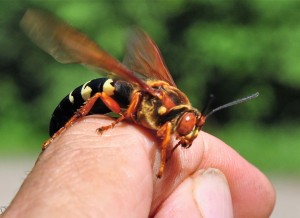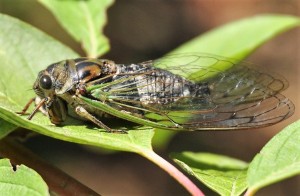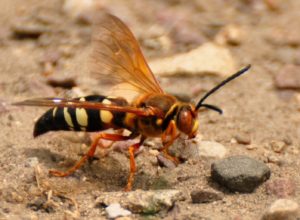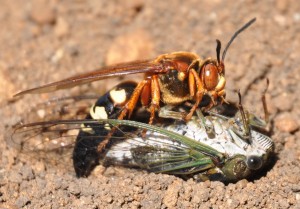Photography courtesy of Lowell Washburn, all rights reserved.
It’s late July; summer is beginning to wane. Right on schedule, this year’s crop of annual cicadas has made their above ground appearance. Often referred to as “locusts”, the distinctive chorus of hopeful males is currently filling the sultry summer atmosphere. With volumes exceeding 100 decibels, the ear-piercing trill is impossible to miss. Louder than your neighbor’s lawn mower; the cicada’s song is the insect equivalent of a dull power saw chewing through plate steel. For many folks, the cicada provides an audible reminder that summer heat is on borrowed time. For others, the harsh buzzing is just one more item on a growing list of warm weather annoyances.
But not all opinions are so negative. Take the giant cicada killer wasp, for example. As far as this six-legged predator is concerned, the cicada’s noisy rattling is the sweetest sound on earth. The admiration is far from mutual though. For emerging cicadas, the perspective is much different. For them, the huge wasps represent their worst nightmare.
Although completely harmless to humans, cicada killer wasps are fearsome winged predators. The annual cicada is their one and only prey. The sole domain of ginormous females, cicada hunting is an aerial pursuit conducted by relentlessly searching the upper canopy of deciduous forests and urban shade trees. Once a cicada is located, the wasp delivers a single powerful sting; injecting a potent shot of venom that instantly immobilizes – but does not kill — its victim. Implementing her onboard computer system, the powerful wasp airlifts her heavy cargo back to a preconstructed ground tunnel. In spite of the cicada’s weight and cumbersome design, the incoming wasp usually dead centers the tunnel’s entrance so precisely that you barely have time to catch a meaningful glimpse before predator and prey disappear into the tunnel. The precision landing becomes even more amazing when considering the cicada’s weight is three times that of the wasp’s.
I’ve read that cicada killers locate prey by homing in on the cicada’s singing. Sounds reasonable, but there has to be more to it. It’s important to note that only male cicadas sing. During the summer of 2013, I observed dozens of wasps over a three-week period. During that time, the hunters arrived at their tunnels with nearly equal numbers of male and female cicadas. Visual cues must be equally important to sound. But regardless of how they actually locate prey, there’s no disputing that cicada killers are extremely efficient at what they do. During the peak of the annual cicada emergence, the wasps’ individual hunt times are incredibly brief; often arriving with new victims every 12 to 15 minutes.
Once the immobilized cicada is spirited below ground, the horror factor escalates. What began as a sunny afternoon of treetop singing for the cicada has now become a nightmare of Stephen King proportions. But the worst is yet to come. What lies ahead for the sedated cicada isn’t likely to make the Mother Goose A-list any time soon. This is where you might want to quit reading this column to your four-year-old.
Upon finally reaching the inky blackness of its underground lair, the cicada killer drops her prey onto the floor the cramped tomb. Once the cicada has been “checked in”, the wasp lays a single egg on her victim. Mission accomplished, the female seals the chamber entrance and leaves. Like a side of beef hanging in your local locker, the paralyzed cicada lies on its back, in the dark, and waits. In two or three days the attached egg hatches, and the wasp larvae immediately begins to devour its helpless, protein packed host. Meanwhile, the larvae’s mother is busy constructing new ‘guest chambers’ and continues filling the summer nursery — one stunned cicada at a time. Capturing cicadas is the wasp’s life mission. Their time on earth is brief, and all adult cicada killers will perish by summer’s end.
Not all cicadas are captured, of course. Those that evade predators will soon deposit their eggs beneath tree bark. As the eggs hatch, tiny nymphs drop to the ground and borough into the soil where they employ spear-like beaks to tap tree roots for sap. Three to five years later, maturing nymphs will tunnel back to the surface. Climbing the nearest tree, the nymph splits its plastic-like skin and the familiar anvil headed adult emerges. Within hours, the sound of singing cicadas will fill the summer air. Although the adults are at least three years old, they are called ‘annual cicadas’ because a new crop emerges above ground each summer.
The first of this year’s cicada killer eggs are already hatching and underground wasp larvae are voraciously consuming their paralyzed hosts. Female wasps supply one stunned cicada for developing males, but two or three for growing females. Amazingly, the mother knows in advance which gender an egg will become. — Don’t ask how. Nobody knows. Once its meal is complete, the larvae will spin a cocoon of sorts and then go dormant; spending the remainder of the summer, fall, and winter in the underground chamber its now deceased mother originally prepared and furnished.
For the majority of their life cycle, cicadas and cicada killer wasps live in complete ignorance of the other’s existence. The next generation of adults won’t appear until July of 2019 when right on schedule, the lives of two seemingly unrelated species will converge with all the synchrony of a perfectly crafted Swiss watch. The cicada’s song will once again fill the late summer air. The annual hunt will begin.





 Tom Cope
Tom Cope Sue Wilkinson
Sue Wilkinson Susan Judkins Josten
Susan Judkins Josten Rudi Roeslein
Rudi Roeslein Elyssa McFarland
Elyssa McFarland Mark Langgin
Mark Langgin Adam Janke
Adam Janke Joe Henry
Joe Henry Kristin Ashenbrenner
Kristin Ashenbrenner Joe Wilkinson
Joe Wilkinson Dr. Tammy Mildenstein
Dr. Tammy Mildenstein Sean McMahon
Sean McMahon